
Blood Diseases
Dr. Salma
“ Disorder of
Homeostasis ”
Total Lec: 41


Disorders of Hemostasis
Dr. salma al-hadad
Objectives
u
To describe the bleeding manifestation; various clinical presentation, laboratory tests and
diagnosis.
u
To list the causes of thrombocytopenia
u
To outline the steps of diagnosis of Idiopathic Thrombocytopenic Purpura (ITP)
u
To describe the clinical manifestation and diagnosis of Hemophilia, Von Willebrand Disease
& Henoch- Schonlein Purpura
Normal Hemostasis
u
It is the active process that clots blood in areas of blood vessel injury, yet
simultaneously limits the clot size only to the areas of injury.
u
As a result of injury to the blood vessel endothelium, three events take place
simultaneously:
I. Vasoconstriction - (vascular phase)
II. Platelet plug formation (primary haemostatic mechanism— (platelet phase)
III. Fibrin thrombus formation (secondary haemostatic mechanism — (plasma
phase)
Hemostatic Failure
Inappropriate and excessive bleeding either spontaneous or in response to injury

Bleeding Manifestations
u
In disorders of hemostasis the bleeding manifestations are commonly present
at more than one site.
1. Spontaneous skin bruising or purpura
2. Bleeding from mucous membranes, e.g. nose/mouth, GIT, urinary &
genital tract
3. Bleeding from venepuncture sites, IV cannulation, operation sites and
from tooth sockets post dental extraction
4. Bleeding into muscles, joints or deep tissues
5. Menorrhagia
6. Cerebral hemorrhage
Clinical Evaluation of Bleeding Patients
“80% of correct diagnosis can be made by history taking and physical examination”
History Taking
u
Identify if the bleeding problem is due to
ü
Local vs. systemic defect
§
Location: single vs. multiple sites
§
Severity: Spontaneous? Appropriate to trauma?
ü
Hereditary vs. acquired disorder
§
Onset
§
Family history
§
Underlying disease
§
Medication
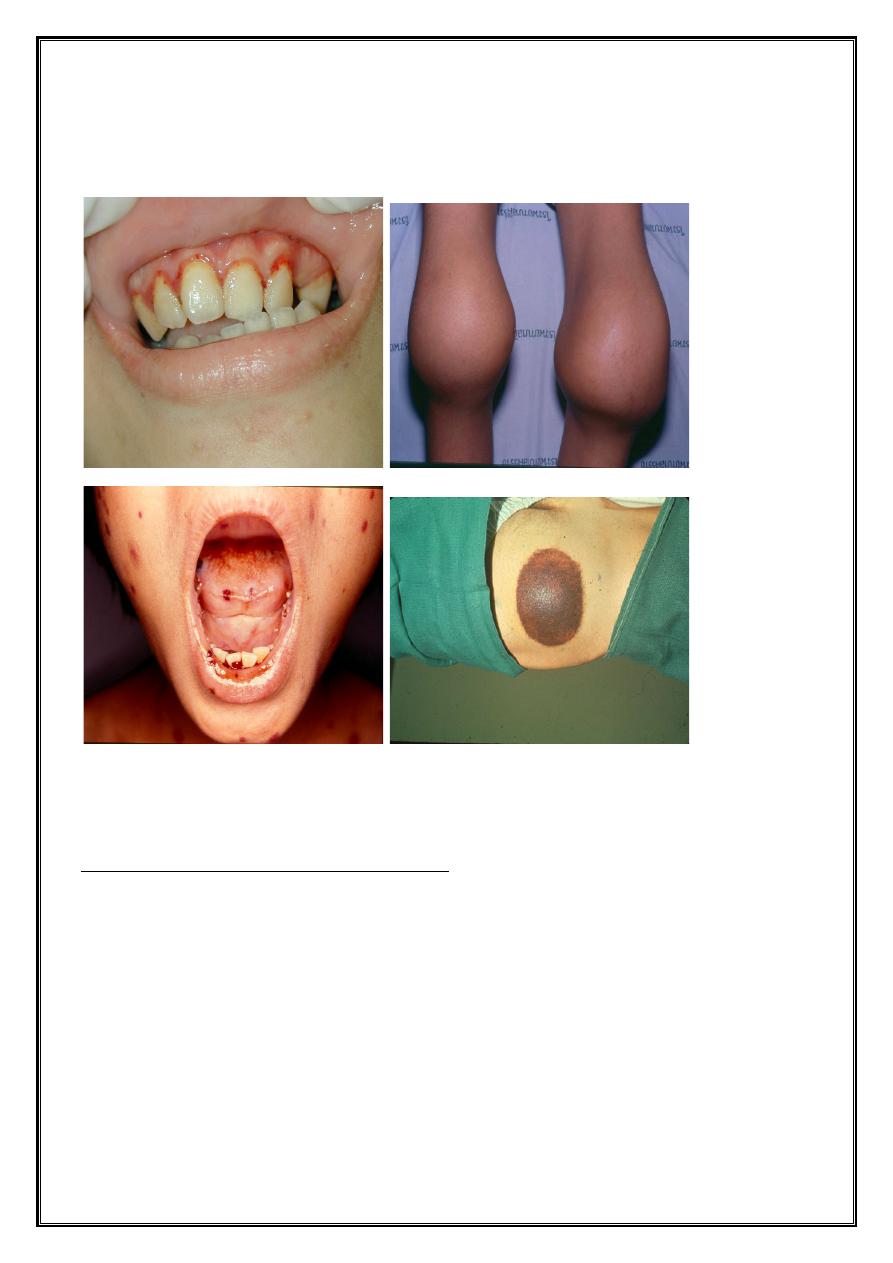
ü
Primary vs. secondary hemostatic disorder
Primary Hemostatic defect Secondary Hemostatic defect
Clinical manifestation of the bleeding
I. Mucosal bleeding; easy bruises, epistaxis, menorrhagia, petechae, and oozing
from surgical wounds is most consistent with a defect in primary hemostasis.
Mostly due to defects in platelets, Von Willebrand Factor, or the vessel wall.
II. Deep tissue bleeding; (hematomas, joint and muscle hemorrhages) and
“delayed” surgical bleeding are more suggestive of a coagulation factor
abnormality, e.g. hemophilia.
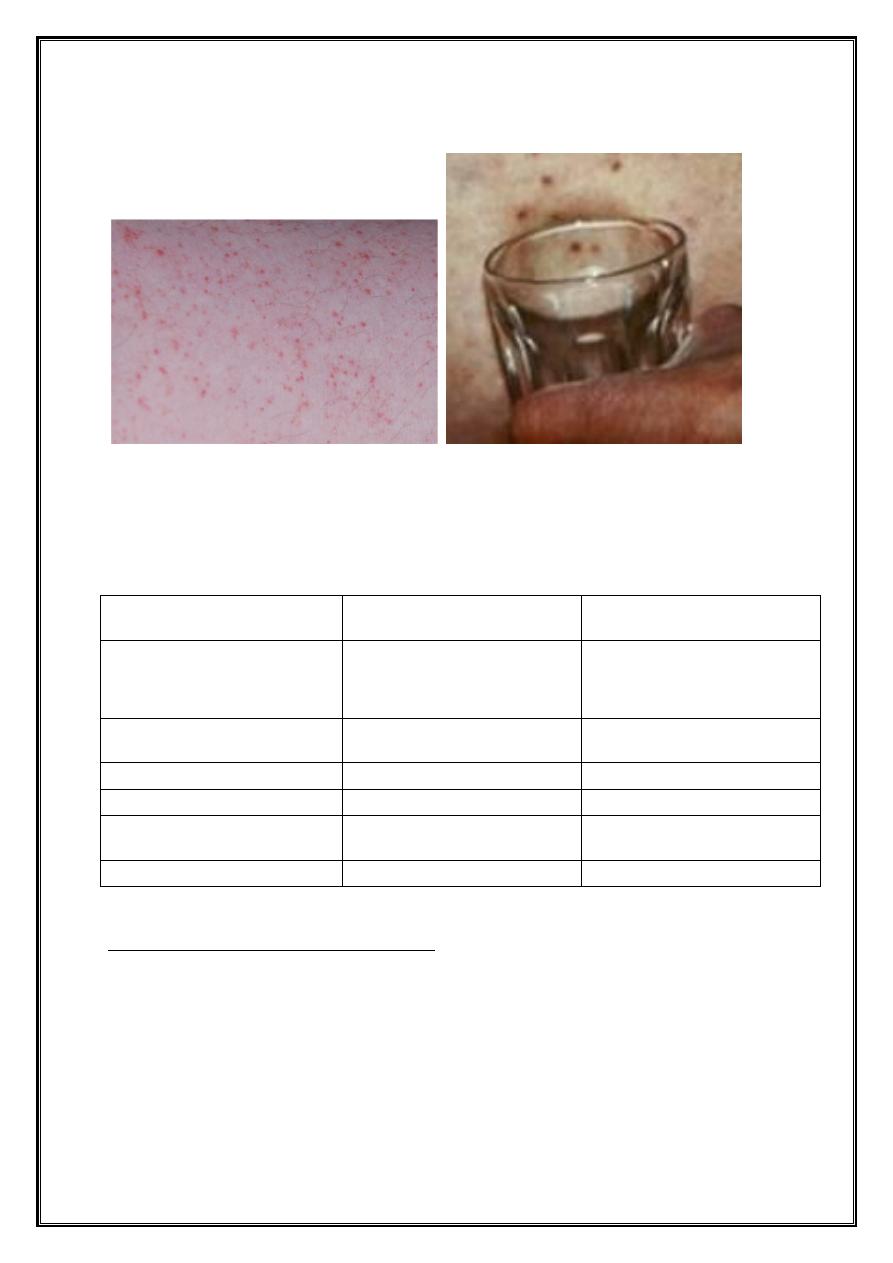
Petechae (typical of platelet disorders)
Do not blanch with pressure, Not palpable
Clinical Manifestations of Hemostasis
Clinical characteristic
Platelets defect
Clotting factor
deficiency
Site of bleeding
Skin, mucous membranes
(gingival, nares, GI and
genitourinary tracts)
Deep in soft tissues
(joints, muscles)
Bleeding after minor
cuts
Yes
Unusual
Petechae
Present
Absent
Ecchymoses
Small, superficial
Large, palpable
Hemarthroses, muscle
hematomas
Rare
Common
Bleeding after surgery
Immediate, mild
Delayed, severe
Clinical Evaluation of Hemostasis
The history should determine:
u
Site or sites of bleeding
u
Duration of hemorrhage
u
Age at onset

u
Severity was the bleeding spontaneous, or did it occur after trauma, did the
symptoms correlate with the degree of injury or trauma?
u
Was there a previous personal or family history of similar problems?
u
If a child has had surgery affecting the mucosal surfaces, e.g. tonsillectomy or
major dental extractions, the absence of bleeding usually rules out a hereditary
bleeding disorder
u
History of Circumcision in males
u
It is important to take a careful menstrual history
u
Drugs: e.g. Anticoagulants, NSAID & Cytotoxics
Laboratory Tests
u
A reliable laboratory approach, including:
ü
First-line (screening) and
ü
second-line (specific) testing,
Essential to screen, diagnose & monitor patients
First-line (screening) tests:
1. CBC: with peripheral smear
2. Bleeding time: bleeding usually stops within 4–8 min, this test should be done
only when platelets count is normal to exclude functional defect
3. Platelet function analyzer(PFA-100): to evaluate the platelet functions and
VWF interaction
4. PT is a measure of the extrinsic (FVII) and common pathway (FV, FX,
prothrombin, fibrinogen) clotting factors.
5. PTT measures the contact system (prekallikrein, FXII) as well as the intrinsic
(FVIII, FIX, FXI) and common pathway clotting factors
6. TT measures fibrinogen deficiency
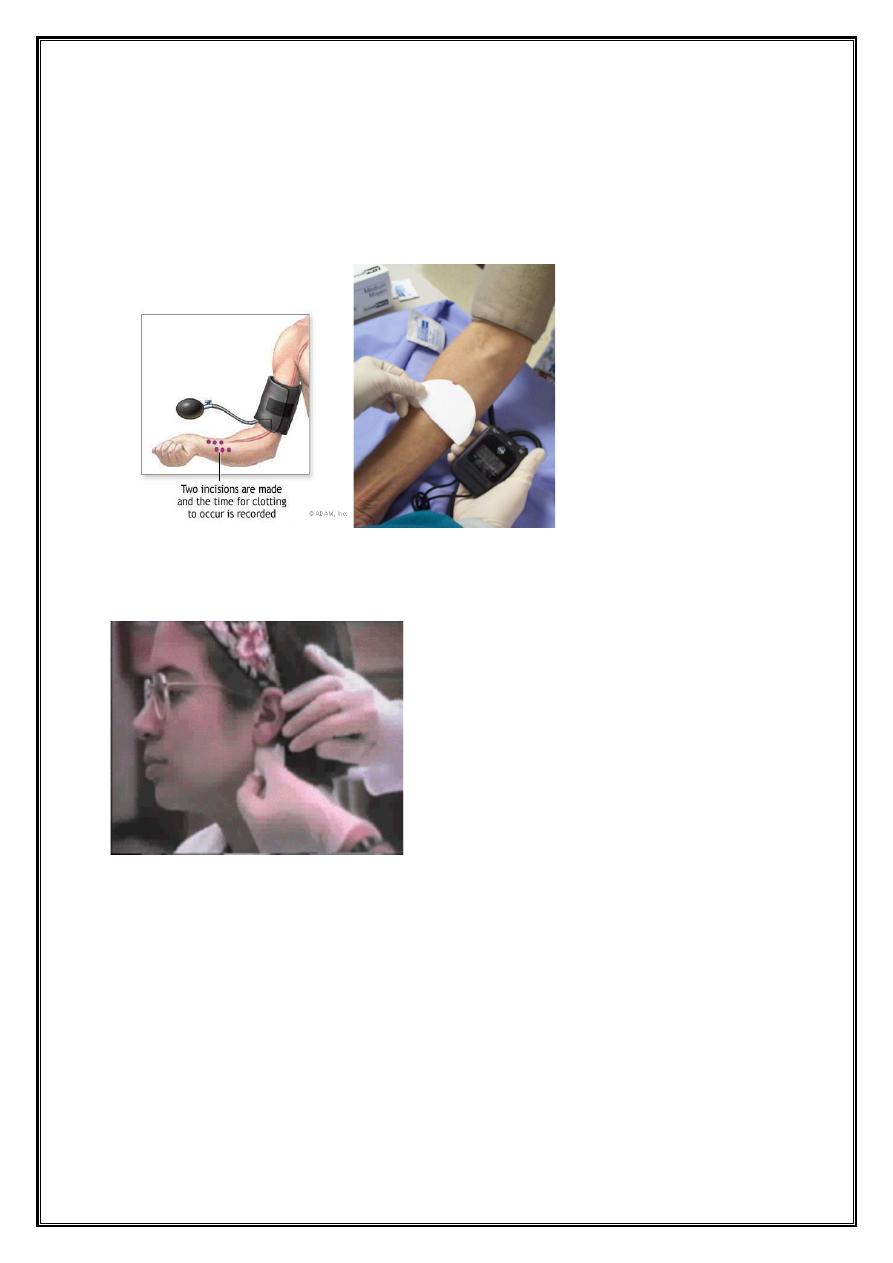
Second-line (specific) tests:
u
Clotting factor assays
Bleeding time test
IVY method
Duke’s test
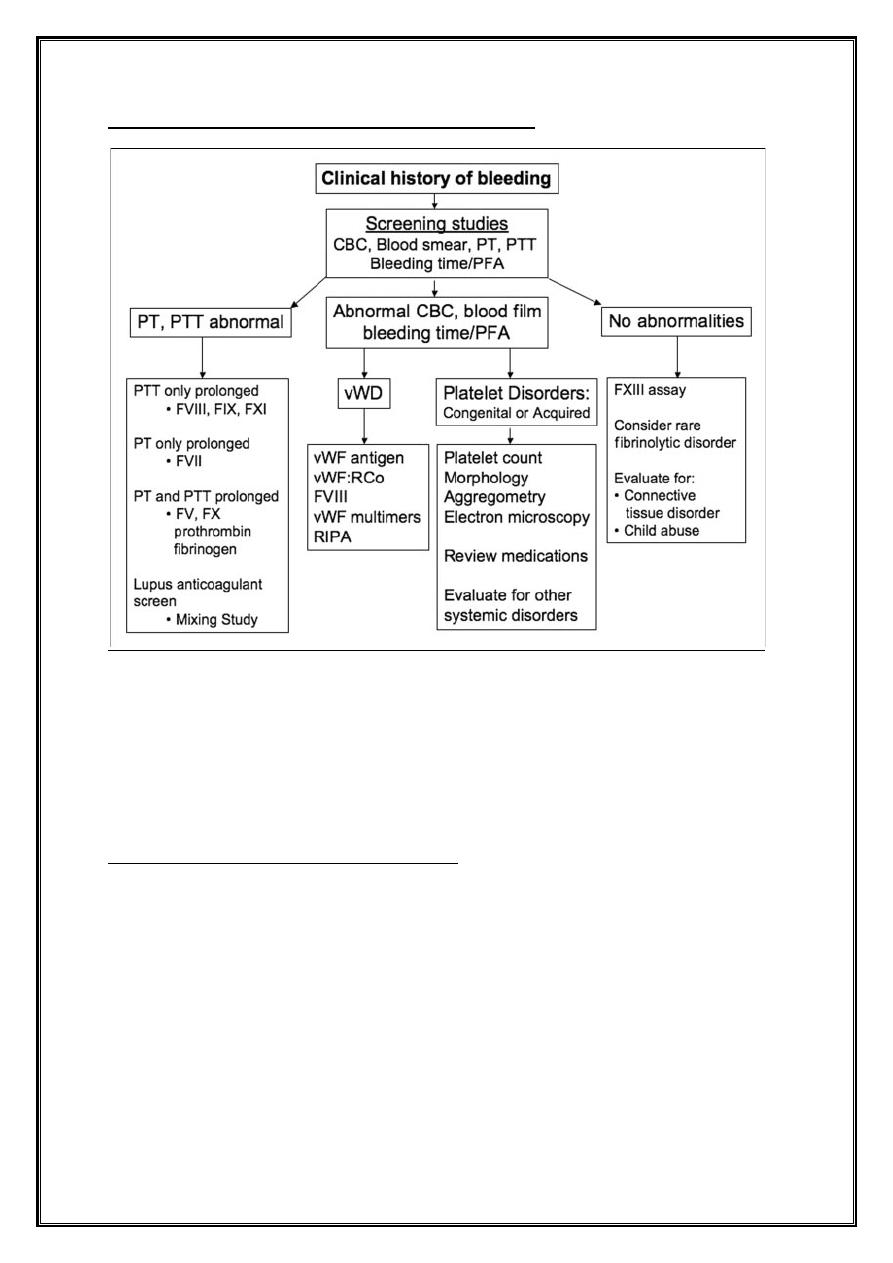
Laboratory evaluation of bleeding disorders
CBC-complete blood count, F-factor, PFA-platelet function analyzer, PT-
prothrombin time, PTT-activated partial thromboplastin time, RIPA-ristocetin-
induced platelet aggregation, vWD-von Willebrand disease, vWF-von Willebrand
factor, vWF:Rco-ristocetin cofactor activity.
Platelet abnormalities- Quantitative
1. Decreased bone marrow production:
a- Malignant marrow infiltration
b- Drugs
c- Severe megaloblastic anemia
d- Hypoplastic anemia
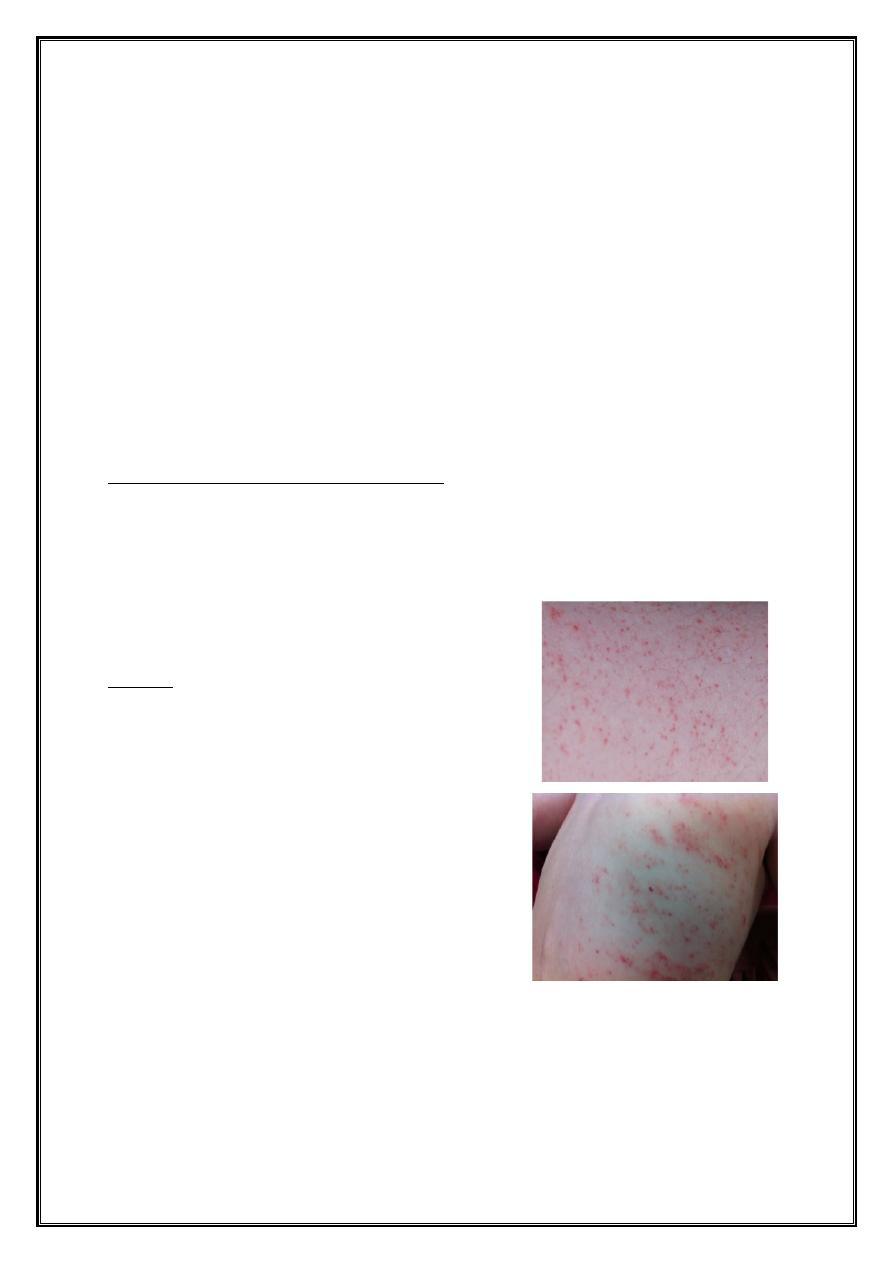
2. Decreased platelet survival (peripheral consumption):
a- Immune mechanisms:
1. Primary —immune thrombocytopenia (ITP)
2. Secondary—SLE, lymphoma
3. Drugs—Thiazides, Sulfonamides
b- Excessive consumption:
Disseminated intravascular coagulation (DIC), splenomegaly (hypersplenism)
Platelet abnormalities- Qualitative
1. Inherited: e.g. Bernard Soulier syndrome, thrombasthenia
2. Acquired: e.g. myeloproliferative diseases, uremia, Drugs, e.g. aspirin
and NSAID.
Case 1
u
4 yr old boy
u
URTI 2 weeks ago
u
Sudden onset bruising/petechiae
u
Past Hx.: Nil
u
Family Hx.: Nil
u
Physical examination:
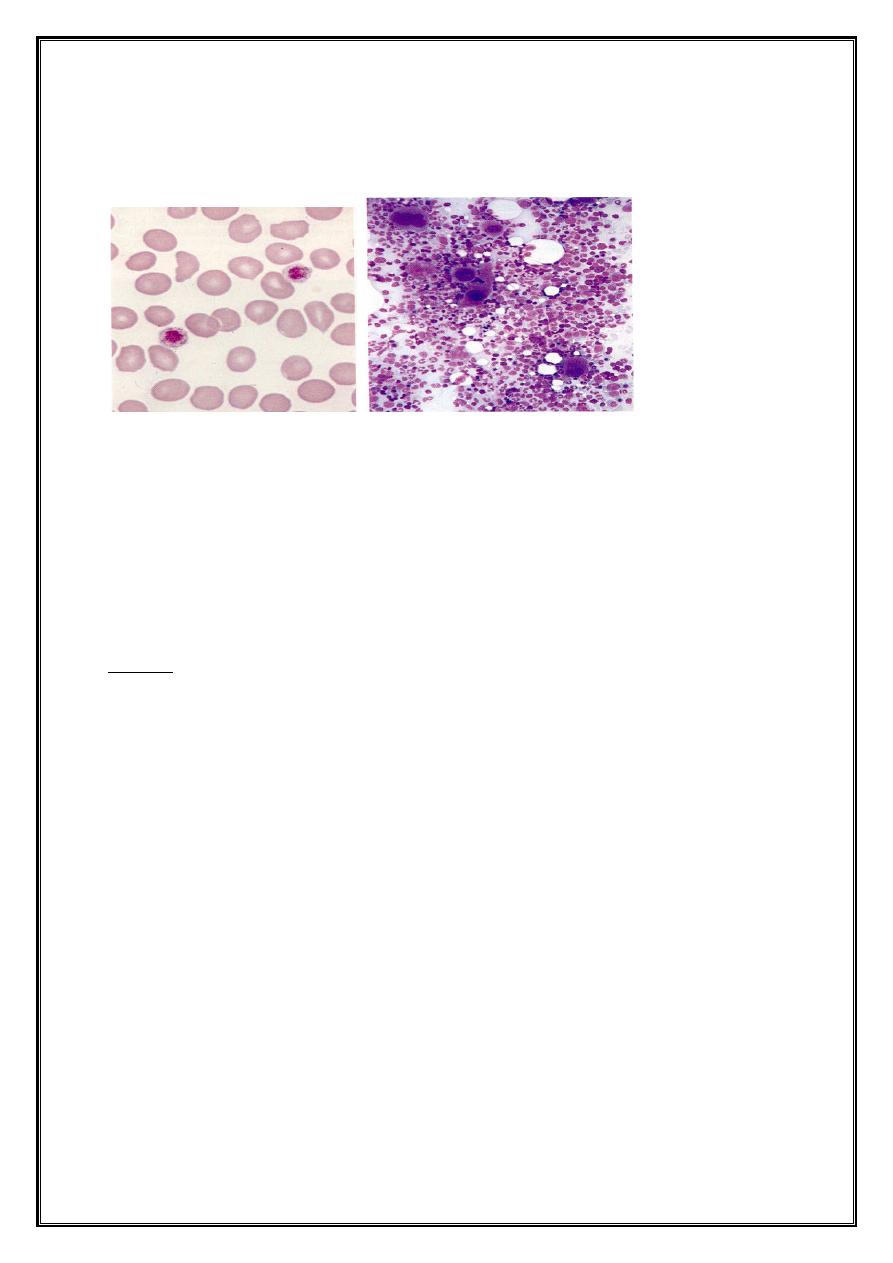
Investigations
u
Hb 11g/dl; WBC 8.000/cmm; Plat. 35.000/cmm.
u
PT 14 sec ; PTT 33 sec; Fibrinogen 2.0g/l
u
Treatment options: Nil
u
Outcome: 80% recovery; 20% chronic
Case 2
u
You are on call for ENT and are asked to see a 14-year old girl with sudden
refractory nosebleed.
u
The nose is packed & bleeding does not stop.
u
You noticed a few bruises
u
The lab results showed with a “critical” platelet count of 10.000/cmm
1. What is likely diagnosis?
2. What to do?
3. What is needed for diagnosis?
4. Does she require hospitalization ?

ITP (Immune Thromboctopenic Purpura)
1. When isolated and very low--- ITP is most likely diagnosis
2. If mucosal bleeding &/or platelets are less than 20.000-30.000/cmm, needs
action:
u
Hospitalization
u
Steroids
u
IVIG
u
Anti D
3. Bone marrow examination
(ITP) Idiopathic Thrombocytopenic Purpura
u
Bleeding disorder characterized by isolated low platelet count (Plts. < 130 - 150
x 10
9
/L)
u
The most common cause of acute onset of thrombocytopenia in an otherwise
well child.
u
1–4 wk after exposure to a common viral infection, an autoantibody directed
against the platelet surface develops
u
Antiplatelet antibody that binds to the platelet surface and enhances its
destruction in the spleen and liver
Clinical Manifestations
u
The classic presentation is that of a previously healthy child who has sudden
onset of generalized petechae and purpura
u
Often there is bleeding from the gums and mucous membranes, particularly
with profound thrombocytopenia (platelet count <10 × 10
9
/L).
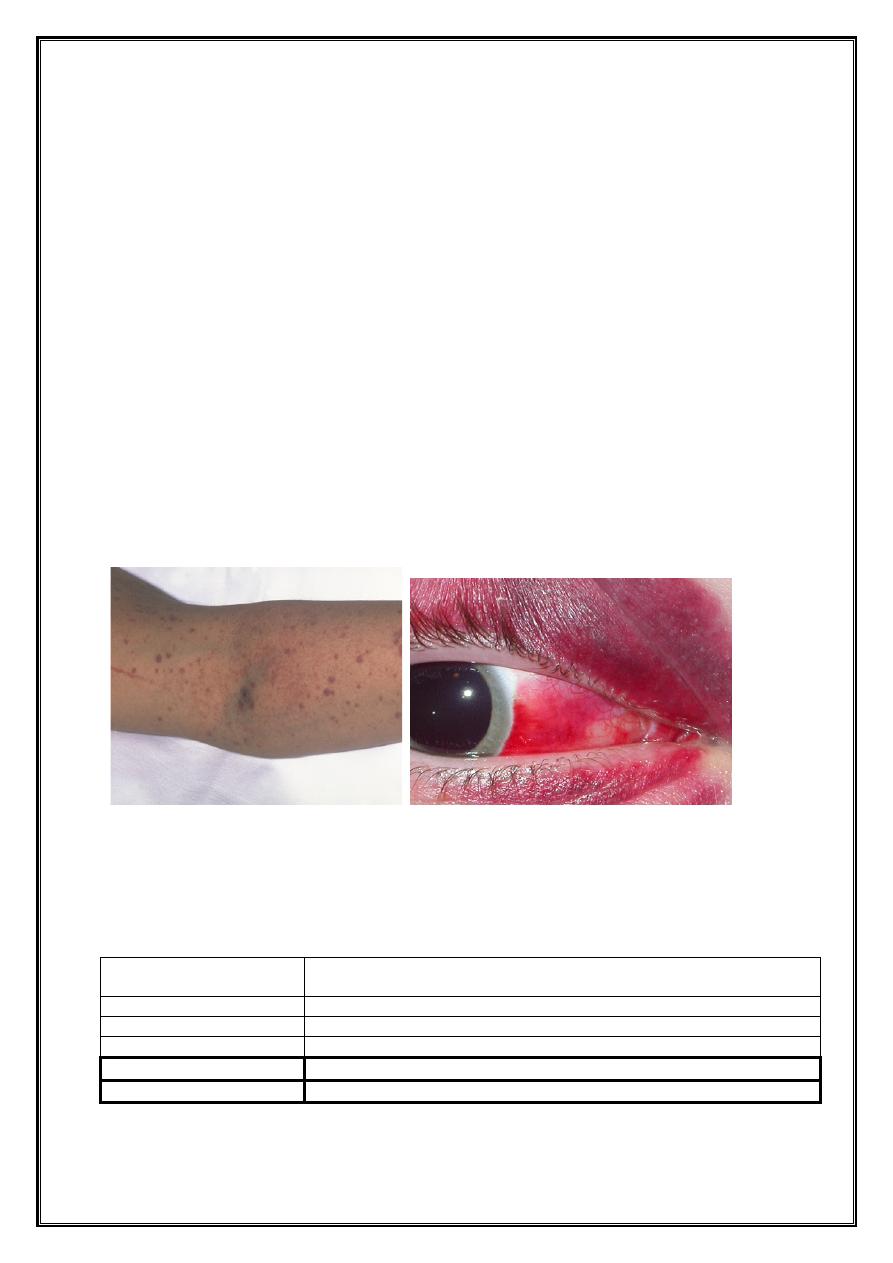
u
Physical exam is normal, other than the finding of petechae and purpura.
u
Absence of HSM or remarkable LAP (which might suggest other diagnoses like
leukemia)
u
No symptoms
u
Mild: bruising and petechae, occasional minor epistaxis, very little interference
with daily living
u
Moderate: more severe skin and mucosal lesions, more troublesome epistaxis
and menorrhagia
u
Severe: bleeding episodes—menorrhagia, epistaxis, melena—requiring
transfusion or hospitalization, symptoms interfering seriously with the quality
of life
Petechae & Ecchymoses Subconjunctival Hemorrhage
Relationship Between Platelet Count & Bleeding
Platelet Count
(10
9
/L)
Signs and Symptoms
>100
None
50 – 100
Minimal (after major trauma & surgery)
20 -50
Mild (cutaneous)
5 – 20
Moderate (cutaneous and mucosal)
<5
Severe (mucosal and CNS)

Laboratory Findings
u
Common finding is platelet count <20 × 10
9
/L
u
Hb, WBC and differential count should be normal
u
BM examination is normal (normal or increased megakaryocytes).
u
Indications for BMA include:
• An abnormal WBC or differential
• Unexplained anemia
• Findings suggestive of bone marrow disease on history & physical
examination.
ITP is a diagnosis of exclusion
u
History: careful drug history
u
Examination: healthy appearing child, no HSM, no LAP, has petechae, purpura
and occasionally mucous membrane bleeding.
u
Blood counts: CBC should be normal except thrombocytopenia
u
Peripheral smear evaluation: essential to
1. Rule out platelets clumping
2. Evaluate WBC and RBC morphology
3. Evaluate size of platelets
General Considerations for Initial Management
u
The goal of all treatment is to achieve an adequate hemostasis (>20 ×10
9
/L) &
prevent the rare intracranial hemorrhage, rather than a normal platelet count.
u
The majority of patients with no bleeding or mild/moderate bleeding can be
treated with observation alone regardless of platelet count.

u
First-line treatment includes:
• Observation,
• Corticosteroids,
• IVIG, or
• anti-D immunoglobulin.
ü
Platelets transfusions should be reserved to life threatening bleeding and CNS
hemorrhage only as their half life is very short in patient with ITP
Prognosis of acute ITP
u
In 70–80% of children who present with acute ITP, spontaneous resolution
occurs within 6 months
u
<1% of patients have intracranial hemorrhage.
u
20% of children go on to have chronic ITP.
Coagulation factor deficiency
Congenital
u
Usually single factor deficiencies.
u
Sometimes clinically apparent at birth, but mild deficiencies may not become
apparent until adolescence or adult life,
u
e.g. Hemophilia A (Factor VIII) and B (Factor IX, Christmas disease), Von
Willebrand disease, Factor XI deficiency

Acquired
u
More common, Usually associated with multiple factor deficiencies, secondary
to underlying disease or drug treatment.
1. Decreased production: e.g. liver disease, Vitamin K deficiency –neonates,
malabsorption
2. Increased consumption: DIC
3. Circulating inhibitors: e.g. antibodies –especially to F. VIII and in SLE
4. Drugs: Heparin and Warfarin.
5. Dilution: massive, rapid blood transfusion
FVIII or FIX Deficiency (Hemophilia A or B)
u
Deficiencies of factors VIII and IX are the most common severe inherited
bleeding disorders.
Clinical Manifestations
u
Neither factor VIII nor factor IX crosses the placenta; bleeding symptoms may
be present from birth.
u
About 2% of neonates with hemophilia sustain intracranial hemorrhages and
30% of male infants with hemophilia bleed with circumcision.
u
Obvious symptoms of easy bruising, intramuscular hematomas, and
hemarthrosis begin when the child “begins to cruise.”
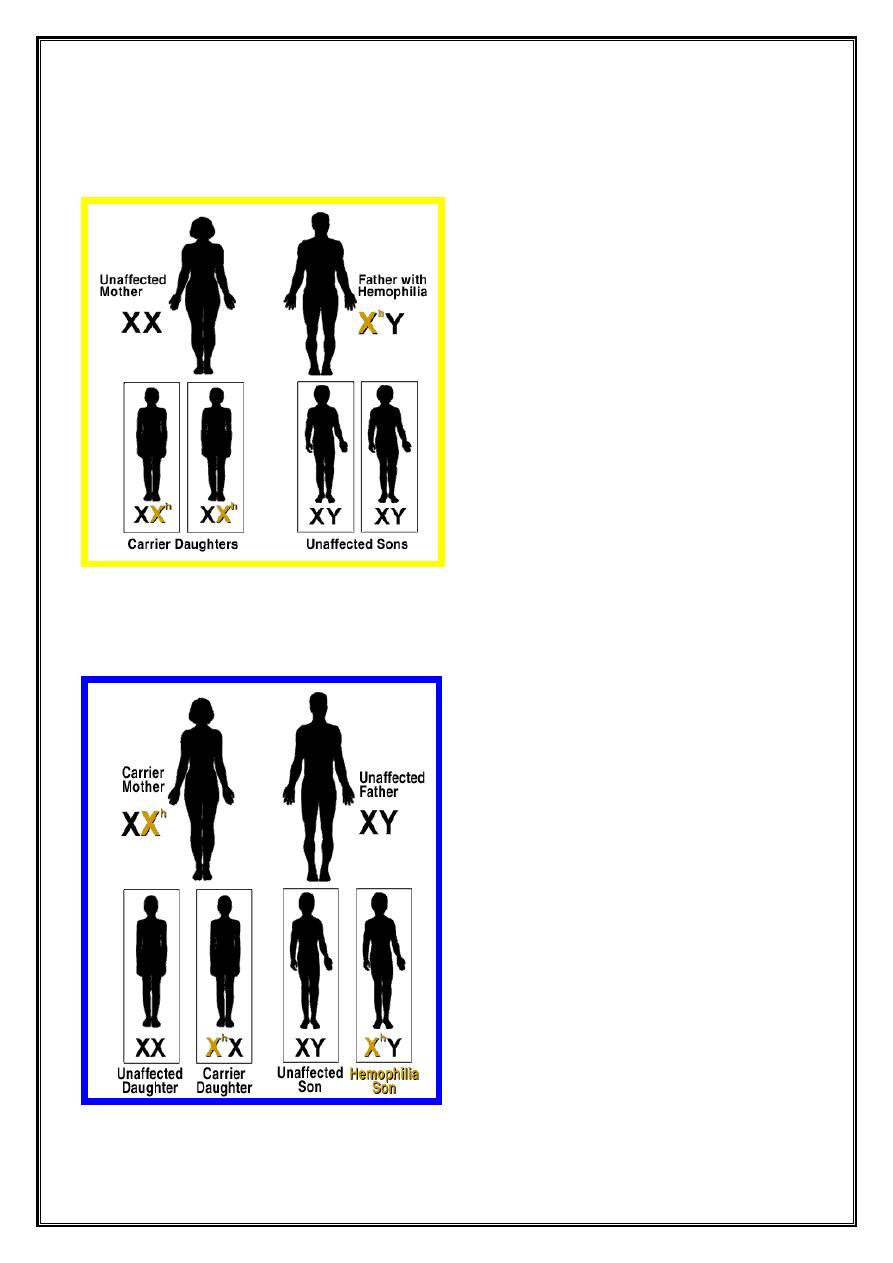
HEMOPHILIA
Non-carrier Mother + Father with Hemophilia
Carrier Mother + Non-hemophiliac Father
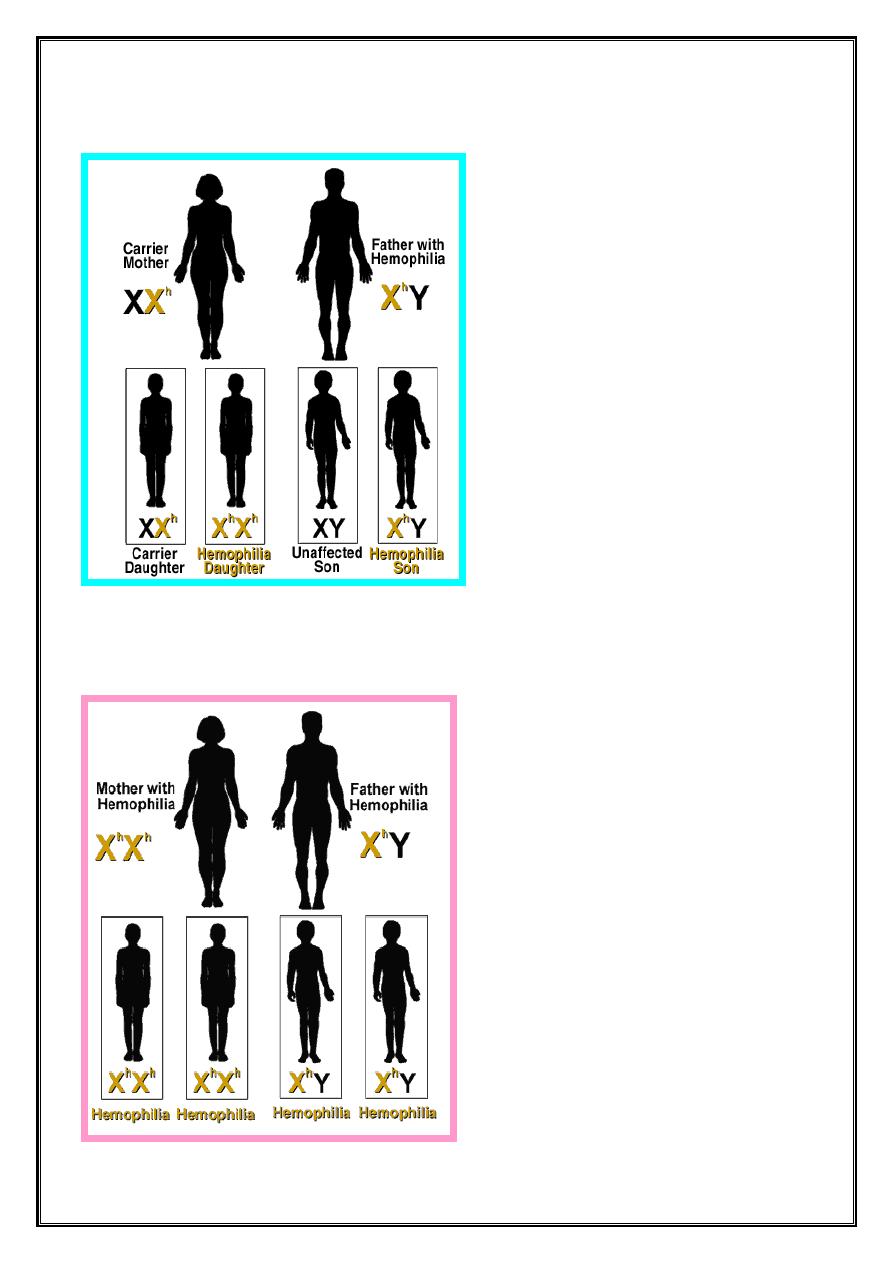
Carrier Mother + Father with Hemophilia
Mother with Hemophilia + Father with Hemophilia
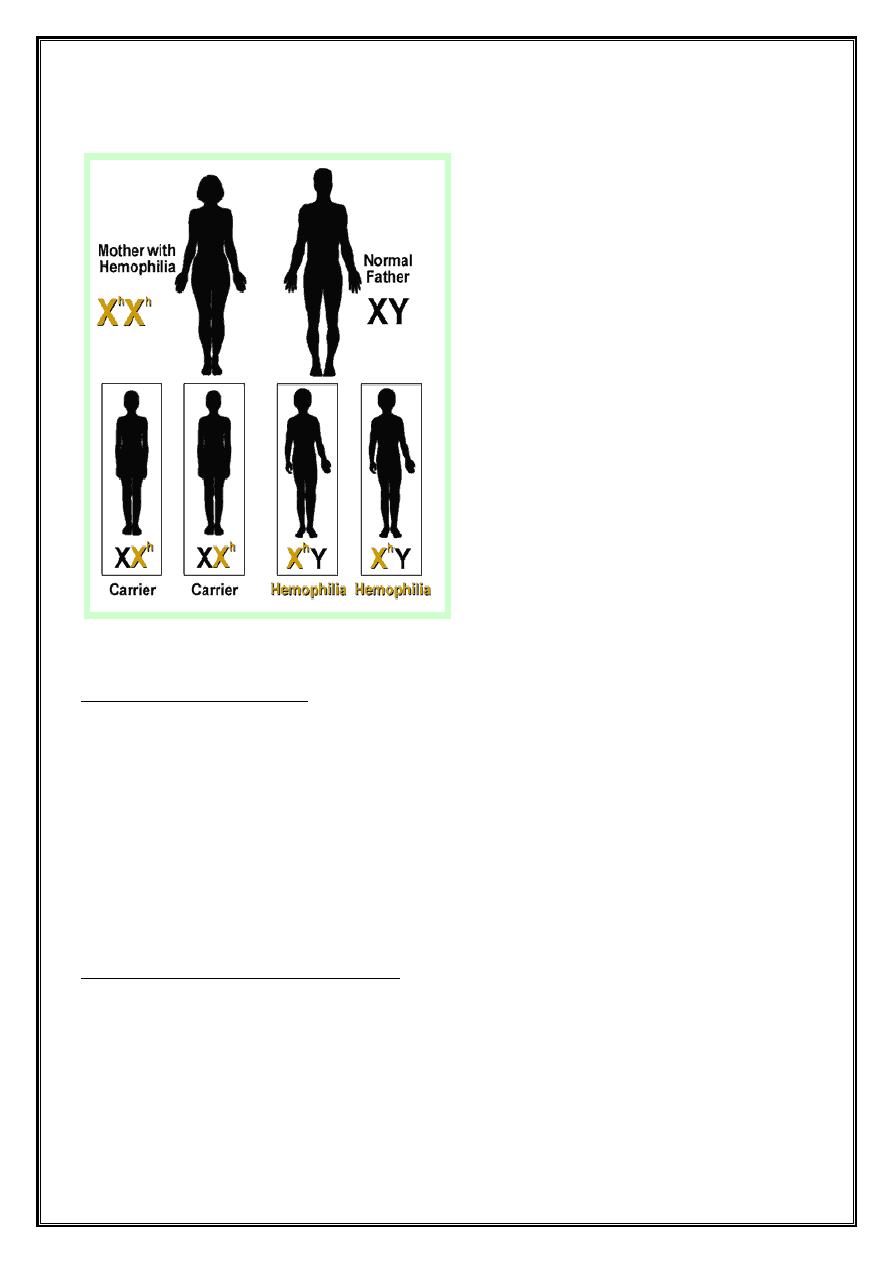
Mother with Hemophilia + Non-hemophiliac Father
Clinical Manifestations
u
The hallmark of hemophilia is hemarthrosis
u
Bleeding into the joints may be induced by minor trauma; many are
spontaneous.
u
Life-threatening bleeding in the patient with hemophilia is caused by bleeding
into vital structures (CNS, upper airway, GIT, or ilio-psoas hemorrhage)
Laboratory Findings & Diagnosis
u
PTT prolonged in FVIII or FIX deficiency
u
Platelet count, bleeding time, prothrombin time, and thrombin time are
normal
u
Specific assay for factors VIII and IX will confirm the diagnosis of hemophilia

Treatment
Early, appropriate therapy is the hallmark of excellent hemophilia care.
1. Factor VIII or IX concentrate:
u
When mild to moderate bleeding occurs, levels of FVIII or FIX must be
raised to hemostatic levels in the 35–50% range
u
For life-threatening or major hemorrhages, the dose should aim to
achieve levels of 100% activity
2. Intranasal Desmopressin in mild hemophilia A, it is not effective in hemophilia
B
3. Prophylaxis treatment: recombinant FVIII or IX products, it was recently
started aiming to be the standard of care for most children with severe
hemophilia to prevent spontaneous bleeding and early joint deformities
Supportive Care
u
Advise parents that their child should avoid trauma
u
Avoid violent contact sports
u
Early psychosocial intervention helps the family to achieve a balance between
overprotection and permissiveness.
u
Avoid Aspirin and NSAIDs that affect platelet function.
u
Receive the vaccinations against hepatitis B, even with the use of recombinant
products
u
Patients exposed to plasma-derived products should be screened periodically
for hepatitis B and C, HIV, and LFT.
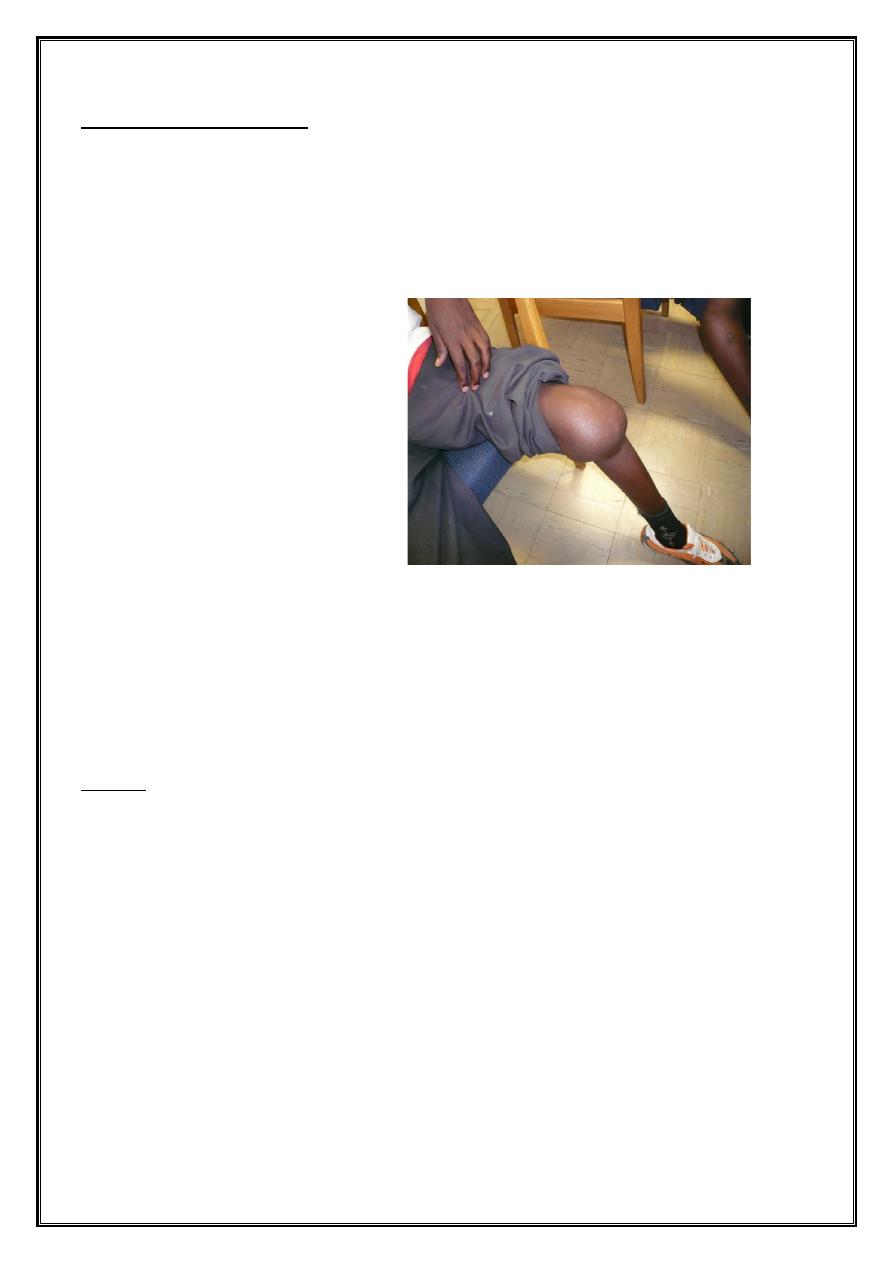
Chronic Complications
u
Long-term complications of hemophilia A and B include:
1. Chronic arthropathy
2. The development of an inhibitor to FVIII or FIX.
3. The risk of transfusion-
transmitted infectious
diseases.
u
Education remains crucial in
hemophilia care
Arthropathy
Case 3
u
14 year old girl with menorrhagia
u
History of easy bruising
u
CBC normal
u
PTT 32 (2 sec prolonged)
u
What is diagnosis?
u
How to diagnose?
u
Treatment?

Von Willebrand’s Disease
u
Most frequent inherited bleeding disorder affect 1-2% of general population
u
less severe than hemophilia
u
Disease results from a decrease or absence of Von Willebrand factor required
for platelet adhesion
u
Affects primary hemostasis
Clinical features of VWD
u
Generally mild bleeding - often unrecognized until surgery or injury
• epistaxis, menorrhagia, easy bruising, dental and post operative bleeding
u
Can be severe in certain types
u
Requires accurate diagnosis
u
Requires specific treatment
VWD –types
u
Type I
• most frequent, quantitative defect (decreased VWf )
u
Type II
• qualitative defect (abnormal VWf )
u
Type III
• severe, rare, (absence of VWf )

Laboratory Findings
u
Long BT and a long PTT
u
Normal results on screening tests do not exclude the diagnosis of VWD
u
if the history is suggestive of a muco-cutaneous bleeding disorder, VWD testing
should be undertaken
Treatment
u
It is directed toward increasing the plasma level of VWF & FVIII.
u
Current replacement therapy uses plasma-derived VWF containing
concentrates that also contain factor VIII.
u
Purified or recombinant VWF concentrates (containing no factor VIII) may
become available in the near future
u
Dental extractions and sometimes nosebleeds can be managed with both
DDAVP & anti fibrinolytic agent
Henoch-Schönlein Purpura
u
Sudden development of a purpuric rash, arthritis, abdominal pain, and renal
involvement.
u
The characteristic rash, consisting of petechae & often palpable purpura,
usually lower extremities & buttocks.
u
Coagulation studies are normal
u
The pathologic lesions in the skin, intestines, and synovium, inflammatory
damage to the endothelium of the capillary mediated by WBC & macrophages
(Vasculitis)
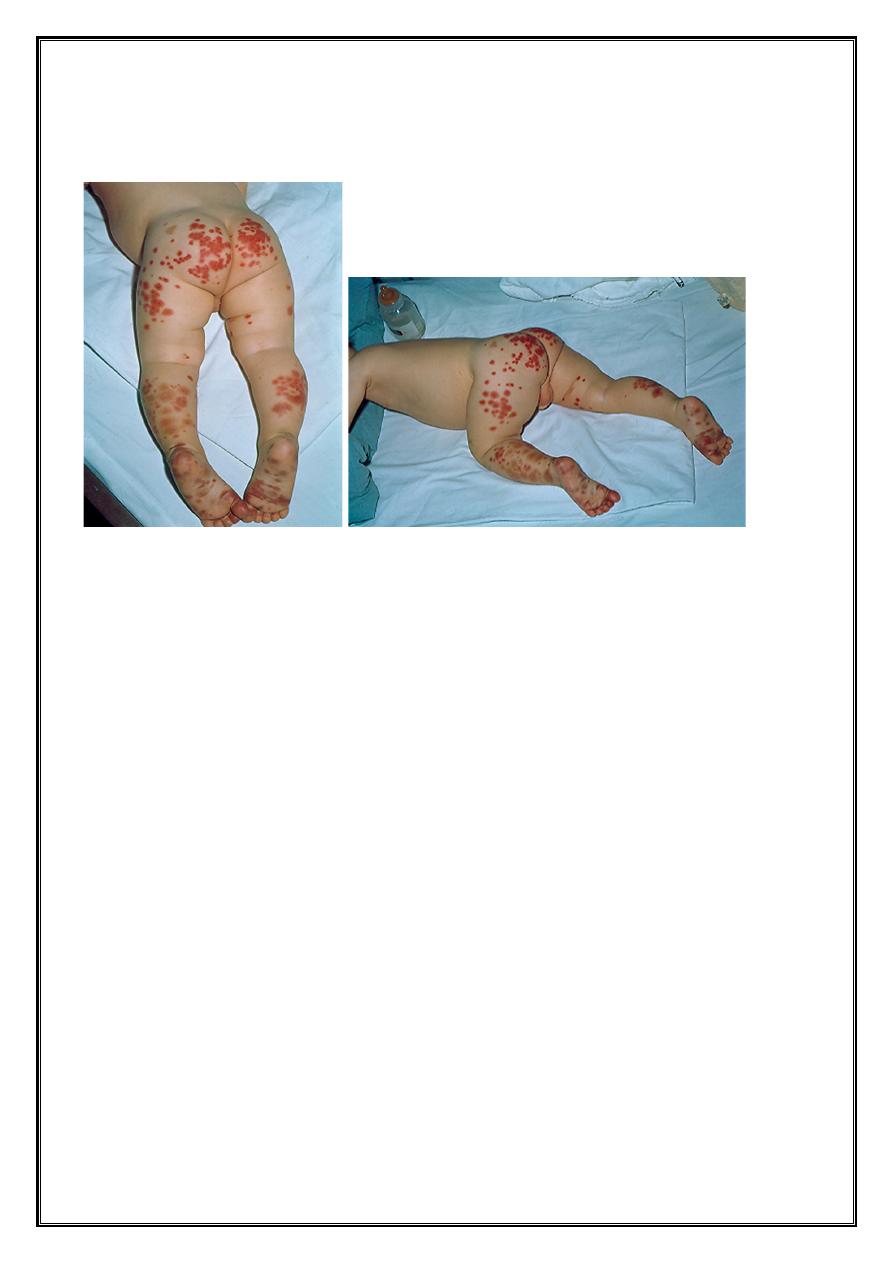
u
The trigger for HSP is unknown. In the kidney, there is focal GN with deposition
of immunoglobulin A.
THANKS
